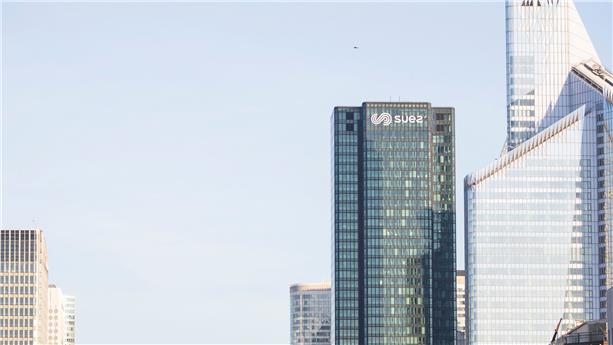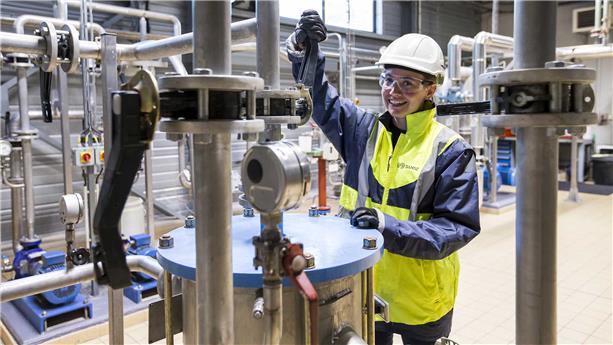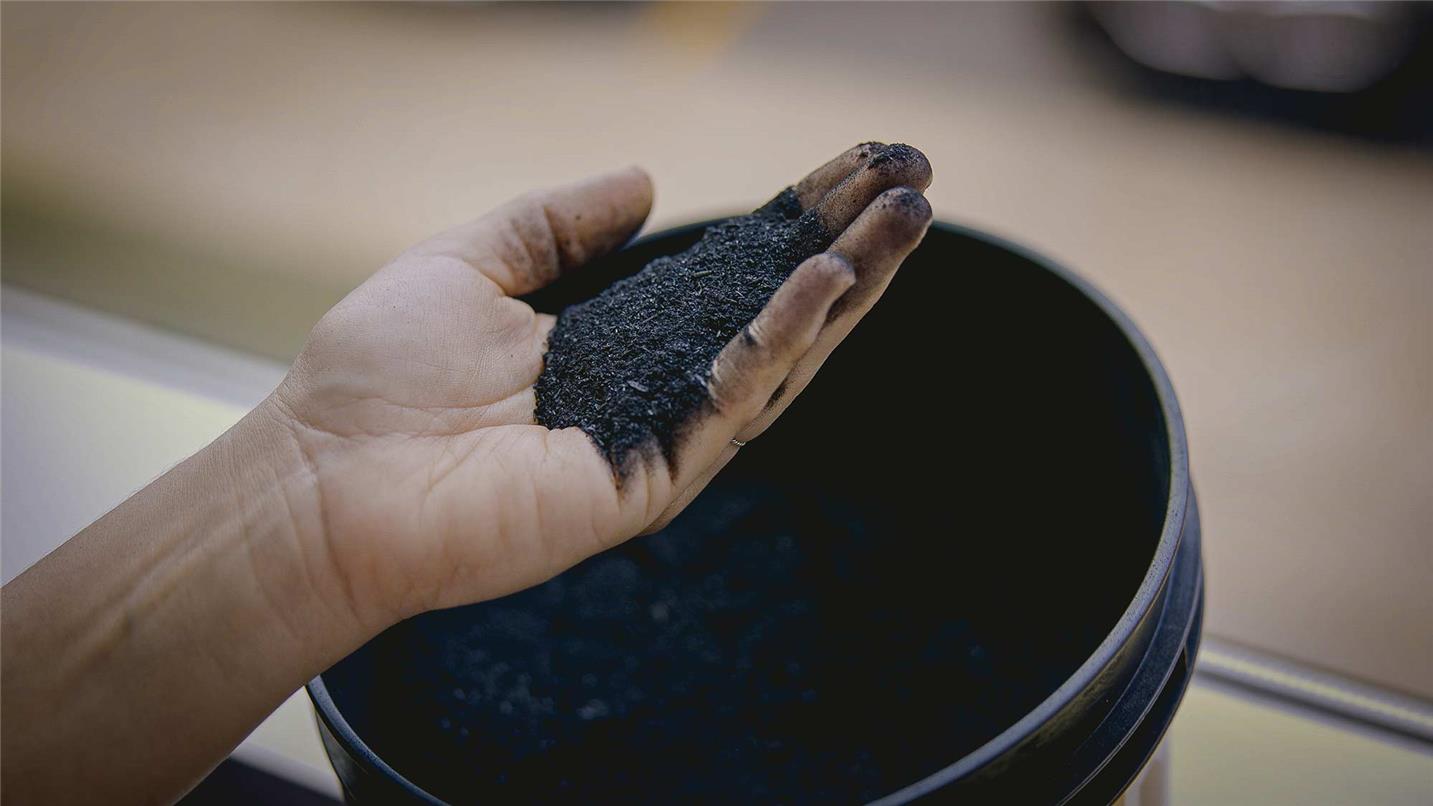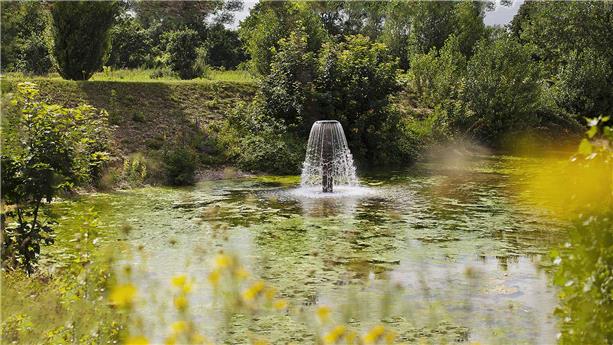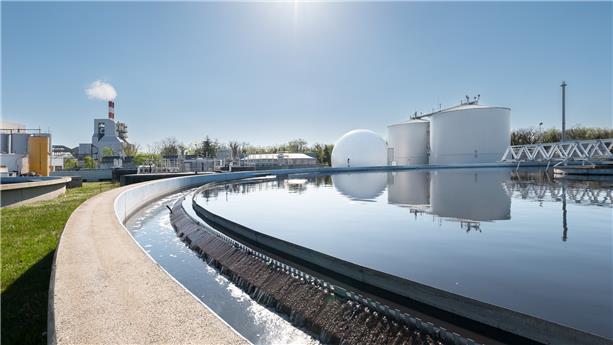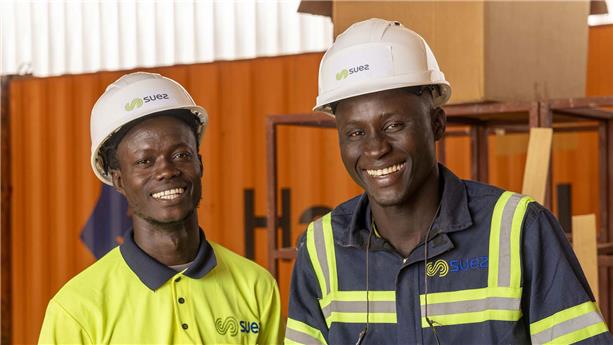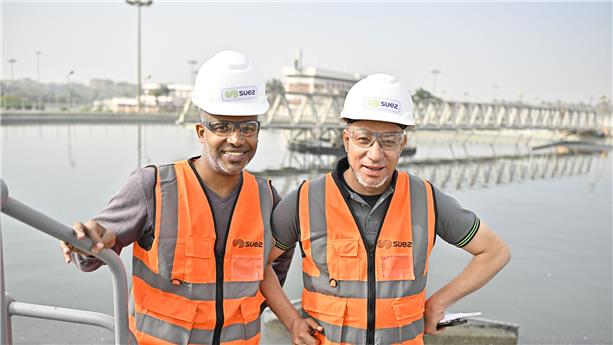
SUEZ is helping to achieve these targets by reducing greenhouse gas emissions from its activities and increasing the proportion of sustainable electricity it uses to 70% by 2030 worldwide and 100% in europe, in keeping with the commitments of its 2023-2027 sustainable development roadmap.
In addition, suez provides local authorities and industrial operators with innovative solutions to reduce the carbon footprint of their facilities. The group is planning for regulatory changes by looking into carbon capture, usage and storage (CCUS) solutions. Tens of millions of euros will be invested between now and 2027 in research and development into ccus solutions that can be used at waste and wastewater treatment plants.
Non-hazardous waste storage facilities accept waste that cannot be recycled or reused. As it decomposes, some of this stored waste emits biogas, which comprises 50% methane, responsible for 18% of the world’s GHG emissions and 3% of GHG emissions in France1. Methane has the same calorific value as fossil natural gas, which makes it a renewable energy of biogenic origin offering attractive opportunities for recovery.
SUEZ, which manages a number of sites around the world, uses its technologies to optimise waste storage in order to protect the environment and combat climate change.
Our innovation in action
20,000 T
1.25 TWh
In Morocco, SUEZ is supporting the country’s environmental transition by means of circular waste management solutions. The city of Meknes in the northwest of the country was home to a 25-hectare illegal rubbish dump, which received around 200,000 tonnes of waste produced by the region’s 650,000 inhabitants each year. This uncontrolled site represented a public health and environmental hazard for local residents. In 2014, in response to the call for tenders from the Moroccan authorities to rehabilitate the site and create a waste recovery and storage centre, SUEZ built an exemplary green landfill site, using sustainable management while also contributing to energy recovery and the circular economy.
The biogas produced at the site is captured by means of wells drilled into the compacted waste and covered with a layer of waterproof clay, thereby reducing biogas emissions into the atmosphere by more than 6 million Nm3 a year, equivalent to 20,000 tonnes of CO2 a year from the decomposition of waste. The biogas captured is then carried via an on-site collection network to be converted into heat and electricity, and to supply the evaporation unit with liquid residues from waste treatment.
5,500 MWh is produced each year at the Meknes plant, which has been energy self-sufficient since 2023. In recognition of these efforts, the plant has been awarded Gold Standard international carbon certification, allowing it to monetise certified carbon credits on the voluntary carbon market to enable industrial operators wanting to make a financial contribution to decarbonisation outside their value chain to benefit.
“The Meknes plant illustrates our ability to combine energy recovery from waste, reducing greenhouse gas emissions and infrastructure performance with a view to sustainable waste management”
Soufiane Jakani, CEO of SUEZ Morocco
—
A symbol of our globalised economies, the transportation sector (air, sea, road) accounts for 21% of the world’s1 greenhouse gas emissions and plays a critical role in speeding up climate2 change. Decarbonising transport is therefore crucial in combating climate change in the years to come.
SUEZ, which produces local and renewable energy by means of waste recovery, helps transportation companies with their decarbonisation efforts in order to speed up the sector’s energy transition.
Our innovation in action
A renewable hydrogen plant to decarbonise urban transport
SUEZ is supporting transportation in the Créteil region through its involvement in the construction of France’s largest renewable hydrogen production plant, attached to the Créteil waste-to-energy recovery unit. As of the end of 2025, the future hydrogen production and distribution plant will produce one tonne of renewable hydrogen per day from waste-to-energy recovery. One tonne of hydrogen is enough to power 1,000 vehicles travelling 100 km a day. It will eventually be able to double its production and distribute up to two tonnes a day.
The tonne of renewable hydrogen produced and distributed each day will be used to power public sector and local authorities’ heavy vehicles fleets (buses, household waste collection vehicles, HGVs, utility vehicles, etc.), as well as personal light vehicles. Once it comes into service, the plant will provide hydrogen for an entire Île-de-France Mobilité bus service operated by the RATP, and will soon be able to charge household waste collection vehicles in the Grand-Paris Sud-Est Avenir area and neighbouring areas.
This project, headed up by SMITDUVM and H2 Créteil – comprising SUEZ, SIPPEREC subsidiary SIPEnR and Banque des Territoires – the company that is building and will operate the plant, is one of the first to produce renewable hydrogen locally at a price as competitive as diesel. It will avoid emissions of around 1,500 tonnes of CO2 equivalent a year.
This hydrogen plant is the latest addition to Créteil’s energy recovery system, which produces heat for the Créteil urban heating network to supply the equivalent of 16,000 households, and energy sold to the public grid, which represents the equivalent of the annual consumption of 35,000 households.
—
“Energy generation and distribution are major issues for the region and its population. [...] This strategy has gained new momentum with the construction of France’s largest renewable hydrogen production plant in Créteil. Hydrogen is central to the energy transition: by replacing fossil fuels, this energy source can be used to power vehicles without emitting greenhouse gases or polluting the air we breathe.”
Laurent Cathala, President of Grand Paris Sud Est Avenir and Mayor of Créteil
—
An unprecedented agreement to decarbonise maritime transport3
In October 2024, SUEZ signed a memorandum of understanding with CMA CGM, one of the world’s leading shipping companies, to establish a long-term industrial partnership for producing biomethane from waste. In October 2024, SUEZ signed a memorandum of understanding with CMA CGM, one of the world’s leading shipping companies, to establish a long-term industrial partnership for producing biomethane from waste. This unprecedented agreement concerns the production of up to 100,000 tonnes of biomethane a year between now and 2030, to power CMA CGM’s 650 ships and help to decarbonise maritime transport in Europe.
100 M€
“The strategic partnership between CMA CGM and SUEZ, one of the key players in the French energy sector, marks an important step forward. It will enable us to support the production of biomethane for maritime transport, while also speeding up the CMA CGM Group’s decarbonisation and safeguarding our aim of being carbon neutral by 2050. This project also makes us more energy self-sufficient, which is a major advantage in gaining.”
Rodolphe Saadé, Chairman and Chief Executive Officer of the CMA CGM Group
—
2 In 2022, electricity generation was still the main emitter of GHGs worldwide, with 39% of total emissions due to fuel combustion. This is followed by transport (21%) and industry (16%, including construction) (source AIA 2024)
3 Maritime transport is responsible for 2-3% of the world’s GHG emissions
Around 340 million tonnes of liquid biomass waste and effluents from industrial and agricultural activities (livestock), residues from methanation plants and sludge from wastewater treatment plants are produced in France each year1. The management and recovery of these effluents represent a growing challenge for local authorities, with regulations tending to limit the practice of spreading on agricultural land.
A number of solutions are available to local authorities to treat and recover this sludge, including, in addition to spreading, methanation of organic matter to produce biogas and digestate for the soil, or even incineration.
Our innovation in action
Hydrothermal gasification is a high pressure (210 to 350 bar) and high temperature (360-700°C) thermochemical conversion process that allows for the conversion of carbon molecules to:
- Produce methane- and hydrogen-rich renewable gas
- Provide fertilising products (potassium, nitrogen and phosphorus) as an alternative to conventional fertilisers
- Recover industrial-quality residual water for irrigation needs. It also plays a role in decontaminating residues by destroying micropollutants and pathogens.
Following this first successful trial, the SUEZ teams began creating an industrial pilot with treatment capacity of 150 litres of sludge per hour at its Terre d’Aquitaine plant in Saint-Selve (Gironde) to test the technological and financial feasibility of the process. The facility, due to become operational in 2026, will treat organic waste from municipal and industrial sources (sewage sludge). The knowledge obtained during the experimentation stage will be used to define and scale up a standard solution that can be reproduced.
SUEZ firmly believes that this innovative solution has a major role to play in the energy and environmental transition of local regions, as it allows for the production of renewable, low-carbon energy and protection of resources (minerals, water) found in sludge, while also reducing treatment waste
3,3 TWh
÷ 15
“With hydrothermal gasification, we are reproducing the conditions in the Earth’s crust for transforming matter (pressure and temperature) to turn organic waste into new materials: renewable gas, minerals and water. We can do in 300 seconds something that it takes nature 300 million years to achieve. This revolutionary process allows for 100% of the materials found in sewage sludge to be recovered and the creation of circular economy loops, in keeping with SUEZ’s aims”
Bruno Hervé, Director Operations & Innovation, SUEZ Engineering & Construction
—
2 Hydrothermal gasification white paper, 2022
We emit around 40 billion tonnes of CO2 a year. To comply with the Paris Agreement and limit temperature rise, taking action is essential, firstly by dividing fossil CO2 emissions from human activity by four between now and 2050. However, it seems that these efforts to reduce emissions will not be enough to achieve carbon neutrality in 2050. Furthermore, we have to remove and store CO2 that is already naturally present in the atmosphere to achieve a quantity of around 10 billion tonnes of CO2 a year by 2050.
There are a number of possible ways of reducing emissions from industry, such as energy efficiency and electrification. Once these means have been activated, some activities still have residual emissions inherent in their processes. To reduce these emissions, the Intergovernmental panel on climate change has identified CCUS – Carbon Capture, Utilisation and Storage – as a key solution.
Our innovation in action
Carbon capture is the first stage of CCUS. SUEZ analyses the various existing carbon capture processes in order to offer the most suitable technologies for each type of project. The Group then looks to turn the captured CO2 into high value-added products, thereby creating a circular economy. Various innovative CO2 recovery solutions have been assessed, such as contributing to the decarbonisation of transport by producing sustainable, low-carbon alternative fuels (eFuels) or developing other innovative uses (new molecules of interest, mineralisation, etc.).
Once captured, the CO2 can also be stored safely and for long time scales. SUEZ is looking into storage solutions in which the CO2 is injected into geological reservoirs for very long-term sequestration (reuse of old gas and oil fields that are no longer in operation, dissolving in deep saline aquifers).
SUEZ has a number of projects in progress, such as in Tees Valley in the United Kingdom, which plans to capture around 900 ktCO2 a year. The CO2 will be transported by pipelines and stored in deep geological cavities in the North Sea. The site is ideally located within a cluster of industrial operators, and a shared CO2 transportation network will be created.
SUEZ also captures CO2 at other types of facilities, such as methanation plants, which produce 100% biogenic CO2. At the Terres d’Aquitaine methanation plant, SUEZ has built a carbon capture and purification unit with Prodeval. The facility, which is in the process of being commissioned, will allow for the recovery of up to 3,500 tonnes of biogenic CO2 a year locally in greenhouses, in order to increase crop yields, as an alternative to CO2 produced from fossil fuels.
3,500 T
“CCUS is essential in addressing the challenge of decarbonisation, particularly for hard to abate industries. We firmly believe that this technology can offer a solution to residual emissions from waste-to- energy recovery units. This is what we are pursuing at the Haverton Hill and Wilton units in the United Kingdom. We aim to roll out this technology on a large scale to speed up the decarbonisation of our activities”
Ludovic Mougeot, Head of the CCUS programme and carbon solutions at SUEZ
—
900 000 T
Our innovation in action
helps industrial operators with their environmental transition, offering its customers innovative solutions to reduce and sequester their greenhouse gas emissions. In July 2023, the Group joined forces with Airex Énergie, a specialist in innovative decarbonisation solutions, and Groupe Rémabec, the largest private forestry company in Quebec, to create the joint venture Carbonity and build Canada’s first biochar production plant in Port-Cartier, Quebec.
Obtained by means of pyrolysis of forestry residue from Groupe Rémabec’s sawmilling activities, biochar allows for carbon found in biomass to be sequestered in a stable and usable form. This process consists of heating biomass residues without oxygen at temperatures of 500 to 600°C in order to stabilise and concentrate the carbon contained in these residues in biochar. Depending on its properties and the biomass converted, the material produced can then be used in urban or agricultural soils or in construction materials. When it is applied to the soil – one of the most common end-uses – the carbon contained in biochar is kept permanently, which makes it an effective carbon well, while also improving the properties of the soil and crop yields. Biochar is also used in construction. When used in concrete or asphalt formulations, it improves the materials’ characteristics while also reducing their carbon footprint, a key issue for the sector. Furthermore, producing biochar at high temperatures creates an energy surplus in the form of steam or pyrolysis oil, which can be used locally, either directly on site or by surrounding industrie
The first tranche of the SUEZ, Airex Énergie and Groupe Rémabec plant came into service in early 2025, producing 10,000 tonnes a year of biochar and recovering some of the forestry residues produced by Groupe Rémabec, representing around 58,000 tonnes a year. The first biochar was produced by Carbonity in early April 2025. The energy surplus is used to supply local industries, which are still highly reliant on fossil fuels. The plant’s annual production capacity will triple by 2026, making it the largest biochar plant in North America and one of the biggest in the world. Once fully up to speed, it will be able to sequester 75,000 tonnes of carbon a year.
350 000 T
Given its size and the three partners’ expertise, this project should eventually increase the availability of biochar on the market and promote the development of the global carbon sequestration market over the long term.
Selling biochar carbon credits helps to offset the residual emissions of companies committed to achieving carbon neutrality, such as Microsoft.
“By transforming forestry and agricultural residues, which are currently not widely used, into carbon wells and organic matter for the soil, SUEZ is creating value across the entire life cycle of the material. We firmly believe that biochar will play a decisive role in combating climate change”
Dominique Hélaine, Carbon Solutions Director at SUEZ
—
